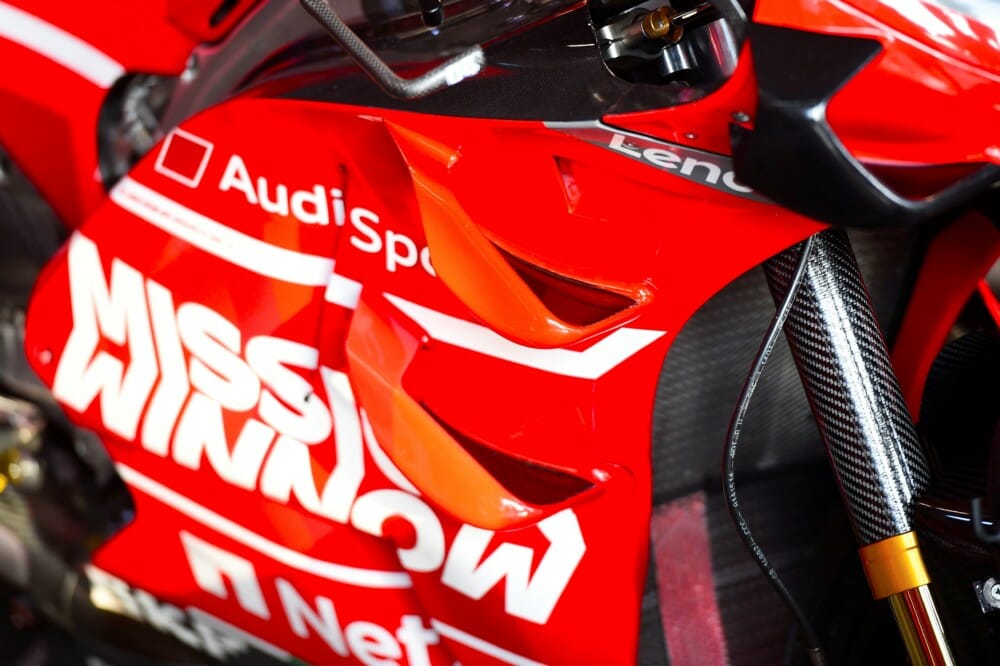Michael Scott | April 23, 2020
Cycle News In The Paddock
COLUMN
Rules, Damn Rules, and Regulations
Newspaper magnate Lord Beaverbrook was recruited by Winston Churchill for a crucial job during World War II—to supervise aircraft production. He hustled through the production of more than 22,000 Spitfire fighters, which played a crucial role in winning the Battle of Britain.
On his office wall, the motto: “Organization Is The Enemy Of Improvisation.”
Grand prix bikes are peacetime fighter planes. Organization is represented by the technical regulations. Today, these fill a rulebook running to more than 300 close-typed pages and covering every aspect, from engine design, dimensions and materials to the bike’s passage through the air.
Much more is banned than allowed.
For the most successful designers, the rulebook has always inspired the creative juices. It’s not quite the same as free thinking and true innovation. But it’s the closest we have to it, and there is an important principle involved.
It is not the letter of the law that matters, but the gaps between the words.
Regs are not to be obeyed, but circumvented.
 All credit to Ducati, whose engineering chief Gigi Dall’Igna’s game of hide-and-seek with the rule makers continues to provide both speed and amusement.
All credit to Ducati, whose engineering chief Gigi Dall’Igna’s game of hide-and-seek with the rule makers continues to provide both speed and amusement.
Years of to and fro between engineers and regulators mean that many loopholes have been closed. Specific materials, techniques, designs and opportunities are banned.
In motorsport, the greater complexity of four wheels allows much more scope: the best example being ground-effect aerodynamics and the Brabham fan-car of 1978. This F1 racer had a huge extractor fan mounted at the rear. Nominally it was for cooling, but the more significant purpose was to suck the car down onto the road. It was withdrawn after one race (which it won by miles) for being just too clever and too good.
In bikes, the innovations are generally in the details. Michelin’s radial tires of the 1970s were one example. Soon afterwards, in the late 1970s, the 16-inch front wheel. Carbon brakes and so-called “upside-down forks” (in retrospect a rather obvious improvement) made the crossover from aircraft in the 1980s.
Freedom in chassis design allowed a number of variations, including several attempts at carbon-fiber (most recently by Ducati) and the famous Suzuki cardboard box, before the fabricated aluminum beam became the norm. KTM is the heretic, with steel tubes, but the real wacky racers emanating from France under the name Elf—with various wishbone or single-link front ends—merely reinforced conventional thinking by its conspicuous failure to improve upon it.
Most of these (tire development apart) were plainly race-focused, with little relevance to the road. Unlike Yamaha’s “pioneering” rear monoshock rear suspension (in fact, the Stevenage-made Vincent had been the true pioneers, making essentially the same thing from the late 1920s). Rising-rate rear linkages later migrated over from motocross.
Latterly electronic innovations have been of the greatest significance, only to be strictly stamped down to one-size-fits-all conformity by control hardware and software. In consequence, street-bike electronics are in many ways more advanced and adventurous.
Tires, likewise, are standardized, while brake materials are as limited as are exotic metals inside the engine. Along with any development of automatic or twin-shift transmissions.
With modern ring-fencing in place, any genuine innovations are to be seriously respected. Honda came out of the blue with Big Bang firing intervals in 1992 (please, not firing order—that’s something different), the principle was twisted into a new shape by Yamaha’s cross-plane crankshaft of 2004, and is now universal in MotoGP.
Honda also pioneered a truly original seamless-shift gear system in 2011, while Honda’s 990cc V5 was also fully original (the same company’s oval pistons of the NR500 weren’t such a good idea).
Of the above innovations, a large proportion have been effectively banned. Cylinder numbers are locked down at four, electronics and tires all identical, brake and engine synthetic materials also have specified limits.
All credit to Ducati, whose engineering chief Gigi Dall’Igna’s game of hide-and-seek with the rule makers continues to provide both speed and amusement.
He got away with their under-swingarm winglet by calling it a tire cooler. Protests by rival factories failed.
Now there’s more lateral thinking with their launch- and now turning-control suspension adjustment, lowering the rear to adjust the overall geometry, firstly to reduce wheelies and secondly to improve mid-corner responses. This neatly sidesteps the ban on electronic suspension by being manually controlled.
But in the end, the regulations generally win. Two major examples prove the point. Perhaps the greatest innovation of all time was MZ’s development of the high-performance two-stroke. The subsequent regulatory elimination of two-strokes stopped development of the ideal motorcycle engine. The other victory over innovation, back in the 1950s, was the banning of all-enveloping dustbin fairing. By specifying an exposed front-wheel, motorcycle aerodynamics suffered a major setback from which they have still not recovered.
So, in a way, Organization actually inspires Innovation. Just within limits.
Perhaps another more clichéd motto applies. “You Don’t Have To Be Crazy To Work Here, But It Helps.”CN